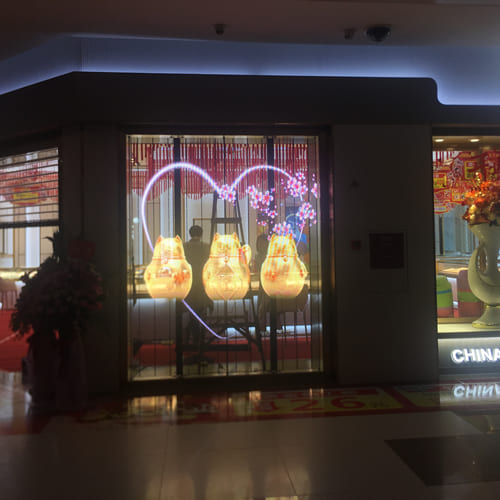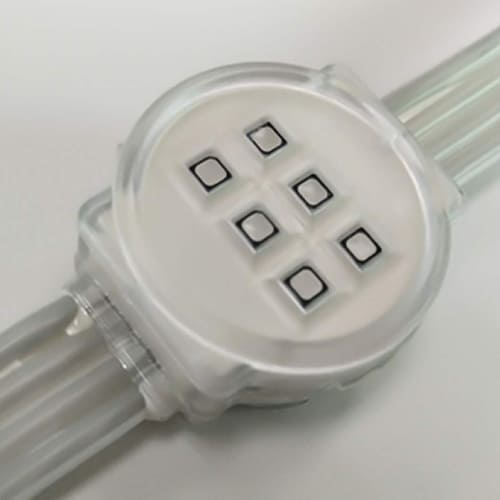What is LED Mesh Ccreen?
Views : 123
Update time : 2025-09-30
LED mesh screens (also known as transparent LED displays or LED curtain screens) are flexible, see-through display panels made up of individual LED modules arranged in a grid pattern with gaps between them. They combine high brightness with partial transparency, making them ideal for creative installations. Here’s a comprehensive breakdown:
Key Features & Structure
| Aspect | Description |
|---|---|
| Transparency | 30–90% light transmission (varies by pixel pitch). Allows visibility through the screen. |
| Pixel Pitch | Ranges from P1.2 to P40mm (smaller pitch = higher resolution, lower transparency). |
| Module Design | LED strips or small modules linked by cables (no solid backing panel). |
| Flexibility | Can curve, wrap columns, or form irregular shapes. Some are rollable. |
| Weight | Ultra-light (5–15 kg/m²) vs. traditional LED displays (30–60 kg/m²). |
How It Works
- LED Arrays: Thousands of SMD LEDs mounted on vertical/horizontal strips.
- Transparency Gaps: LEDs cover only 10–70% of the surface; gaps allow light/airflow.
- Control System: Receives video content via HDMI/SDI, processed by a controller.
- Power & Data: Slim cables transmit power/data between modules (hidden in mesh gaps).
Applications
| Use Case | Examples | Benefits |
|---|---|---|
| Building Facades | Media art on skyscrapers, retail windows. | Preserves views & natural light. |
| Event Stages | Concert backdrops, exhibition booths, runways | Creates 3D “floating” visuals. |
| Indoor Installations | Malls, airports, museums. | Space-saving, modern aesthetic. |
| TV Studios | Virtual sets, weather backgrounds. | Enhances AR effects with transparency. |
Technical Specifications
| Parameter | Typical Range | Impact |
|---|---|---|
| Brightness | 5,000–8,000 nits (outdoor); 1,500–3,000 nits (indoor) | Visible in direct sunlight. |
| Refresh Rate | ≥3,840Hz | Eliminates flicker in camera recordings. |
| Viewing Angle | 140°–160° (H/V) | Wide visibility range. |
| IP Rating | IP65 (outdoor); IP43 (indoor) | Weather/water resistance. |
| Lifespan | 80,000–100,000 hours | Low maintenance. |
Pros & Cons
✅ Advantages:
- Aesthetic: Seamless integration with architecture.
- Ventilation: Allows airflow (crucial for building facades).
- Energy Efficient: Lower power vs. solid LED walls (fewer LEDs/m²).
- Easy Installation: Lightweight; hangs from cables or structures.
❌ Limitations:
- Lower Resolution: Gaps reduce pixel density (not ideal for close viewing).
- Content Adaptation: Graphics must be designed for transparency (e.g., black = transparent).
- Cost: ~800–3,000/m² (higher than conventional displays).
Selection Guide
- Pixel Pitch: Choose based on viewing distance:
-
10m distance: P10–P25mm
- <10m distance: P3.9–P6mm
- Indoor retail: P1.9–P3.9mm
-
- Transparency Needs:
- High visibility required? → P10+mm (70–90% transparency).
- Prioritize resolution? → P4–P6mm (40–60% transparency).
- Installation Environment:
- Outdoor → IP65+, high brightness (≥6,000 nits).
- Curved surfaces → Flexible mesh (bend radius ≥500mm).
💡 Pro Tip: For stage designs, combine multiple layers of LED mesh for holographic 3D effects!
Leading Brands
- Outdoor: Unilumin, Leyard, Absen
- Indoor/Fine Pitch: LG Transparent OLED (for comparison), Silicon Core, Tecnon
- Budget: Auroled, INFiLED
Future Trends
- Higher Transparency: Targeting >90% with micro-LED tech.
- Interactive Mesh: Embedded sensors for touch/gesture control.
- Energy Harvesting: Solar cells integrated into transparent areas.
LED mesh screens redefine visual communication by blending digital content with physical environments. For installations, always consult a specialist to optimize pixel pitch, content design, and structural support! 🌆
Related News
 Outdoor LED Display Panel Price
Outdoor LED Display Panel Price
2025-11-06
The cost of outdoor LED display panels varies significantly based on pixel pitch (P3, P4, P5, etc.)
 What professional LED pixel calibration tools are there?
What professional LED pixel calibration tools are there?
2025-09-30
Here's a professional-grade LED pixel calibration toolkit comparison for broadcast, architect
 How to perform pixel calibration on an LED mesh screen?
How to perform pixel calibration on an LED mesh screen?
2025-09-30
Performing pixel calibration on an LED mesh screen requires specialized tools and techniques to addr
 How to maintain an LED mesh screen?
How to maintain an LED mesh screen?
2025-09-30
Maintaining an LED mesh screen requires proactive care tailored to its transparency, outdoor exposu
